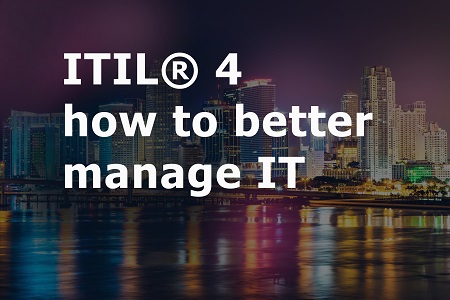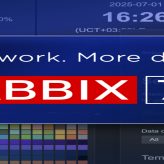

ITIL® 4 how to better manage IT
22. 7. 2020
TIL is the world’s most recognized framework for IT-enabled services and has provided comprehensive, practical and proven leadership to 90% of Fortune 500 companies for more than 30 years.
ITIL was founded in the 80’s and was originally created by the UK government. He is now the owner of the Axelos methodology. The current version is ITIL 4 (February 2019) and is an update of the previous version of ITIL v3, resp. ITIL 2011.
ITIL 4 is the most significant update, which is more flexible, more agile and linked to other standards and methods. It helps IT managers effectively build, develop and optimize user-friendly IT. Both for suppliers and for clients (users) of IT services. In addition, it is compatible with a number of other standards, such as PRINCE2, SCRUM, DevOps, IT4IT.
ITIL 4 has already helped many successful organizations create valuable results that meet growing customer demands. This is a set of best practices and, thanks to a recent update, remains relevant to modern businesses after 30 years. In the coming weeks, we will take a closer look at the individual ITIL 4 modules.
The ITIL 4 framework consists of seven basic modules:
- ITIL 4 Foundation
- ITIL 4 Specialist: Create, Deliver and Support (CDS)
- ITIL 4 Specialist: Drive Stakeholder Value (DSV)
- ITIL 4 Specialist: High-velocity IT (HVIT)
- ITIL 4 Strategist: Direct, Plan and Improve (DPI)
- ITIL 4 Leader: Digital and IT Strategy (v přípravě)
- ITIL 4 Master (v přípravě)
WHAT HAS CHANGED?
The key elements of ITIL 4 are the four dimension, the guiding principles, the transition from processes to procedures and the Service Value System, which provides a holistic approach to joint value creation through service relationships.
Service Value System
The service value system (SVS) is a key component of ITIL 4, which facilitates value co-creation. It describes how all the components and activities of an organization work together to enable value creation. As the SVS has interfaces with other organizations it forms an ecosystem and can also create value for those organizations, their customers and stakeholders.
At the heart of the SVS is the service value chain – a flexible operating model for the creation, delivery and continual improvement of services. The service value chain defines six key activities:
- plan
- improve
- engage
- design
- transition – obtain/build
- deliver and support
They can be combined in many different sequences, which means the service value chain allows an organization to define a number of variants of value streams, e.g. the v3 service lifecycle.
The flexibility of the service value chain allows an organization to effectively and efficiently react to changing demands from stakeholders.
FOUR DIMENSIONS
It defines four dimensions that are critical to the successful facilitation of value for customers and other stakeholders.
- Organizations and people: An organization needs a culture that supports its objectives, and the right level of capacity and competency among its workforce.
- Information and technology: In the SVS context, this includes the information and knowledge as well as the technologies required for the management of services.
- Partners and suppliers: This refers to an organization’s relationships with those other businesses that are involved in the design, deployment, delivery, support, and continual improvement of services.
- Value streams and processes: How the various parts of the organization work in an integrated and coordinated way is important to enable value creation through products and services.
It’s essential that an appropriate amount of focus is given to each of these dimensions so that the SVS remains balanced and effective.
The ITIL 4 guiding principles are:
- Focus on value
- Start where you are
- Progress iteratively with feedback
- Collaborate and promote visibility
- Think and work holistically
- Keep it simple and practical
- Optimize and automate
ITIL CERTIFICATION
The ITIL 4 certification scheme is developed to remain compatible with the existing certification scheme. This means that all existing certifications remain valid until they are replaced by an update. If you also collect points within the Axelos program, you also have all the credits that you can easily transfer to the new certification scheme.
The ITIL 4 certification scheme will offer several levels.
The basis remains the ITIL 4 Foundation. Another module is ITIL Specialist, which contains 3 programs, ITIL Strategist, ITIL Leader and ITIL Master. A certification exam is a mandatory part of every course.
How to switch from ITIL v3 to ITIL 4? Take advantage of the ITIL 4 Managing Professional transition module is designed to allow candidates who have already completed ITIL v3 to easily upgrade to the new version 4. They can earn the ITIL 4 Managing Professional designation through one training session and one exam.
Have you seen our ITIL 4 video series? If not, watch the youtube channel “edutrainings”. The series was prepared for you by EDU Trainings in cooperation with lecturer Ludmila Vráželová.
©Copyright 2020 EDU Trainings s.r.o. The information contained herein is subject to change without notice. Nothing herein should by construed as constituting an additional warranty. EDU Trainings s.r.o. shall not be liable for technical or editorial errors or omissions contained herein. Courses are delivered in association with Accredited Training Organization ATO Experts, Ltd. PRINCE2® and ITIL® are registered trade marks of AXELOS Limited, used under permission of AXELOS Limited. All rights reserved. Copyright © AXELOS Limited 2019. Used under permission of AXELOS Limited. All rights reserved.


